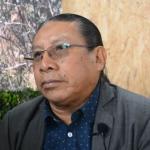In this CAPLAC, for the first time, Indigenous Peoples of Latin America and the Caribbean are members of IUCN, and they had an opportunity to engage with IUCN formally within this Congress. From your perspective, as a forest representative at the Mesoamerican level, what are the priorities of Indigenous Peoples for this CAPLAC?
The priority is more than a request, it is compliance with the resolutions adopted at the various IUCN congresses: Durban, Barcelona, the second Latin American Congress in Bariloche, where the rights of indigenous peoples over their territory and natural resources were reaffirmed. What we request is that these agreements, these resolutions, be implemented in each of the countries and not just remain as one more resolution.
For the first time in a IUCN Congress, IPOs are members and will be able to participate in the voting process. What would you like IPOs to contribute to the discussions at the IUCN Congress 2020? What decisions would you like to see taken as a result of that Congress in relation to indigenous peoples?
I believe that here, in the framework of the III Latin American Congress of Protected Areas, we had an IPO dialogue session with IUCN. The Hawai'i Congress, for example, adopted the issue of revising the category of the indigenous peoples' system on conservation. So I think this is the most essential request. Then I think it is the backing of the action plans that must be in place along with the work. We think that what is happening with IUCN is membership, the membership group that was created at the Hawai'i Congress for Indigenous Peoples. I believe that this is one of the positive things that contribute, and we are actively engaged, and I think between now and the Congress, there will be many organizations and indigenous peoples applying to become IUCN members.
Can you give me an example of some traditional practices in your territory that contribute to conservation?
We indigenous peoples are not conservationists. We have to have a middle ground, because we use natural resources and, at the same time, we preserve them. One example is the case of lobster fishing. In my territory, no diving is allowed with oxygen tanks. All fishing, whether for fish, lobster or crustacean, has to be done with your own lungs. For us, this is a way of controlling and contributing to conservation. Because there are many places where you see that resources are overexploited. Why? When you use oxygen tanks, it gives you plenty of time to fish. So, this is an example of how we are contributing to conservation.
Starting in 2020, strategic policy events will take place. This is the IUCN Congress and the Conference of the Parties (COP) to the Convention on Biological Diversity (CBD). What would you like to bring to the discussions, as an IPO leader, in relation to nature conservation issues?
I think that, by 2020, we will already be closing what I can call the discourses phase, the agreements phase, and after 2020, we will have to move to concrete actions and gather everything that Indigenous Peoples do for conservation welfare, and contribute and incentivize these Indigenous Peoples. And so we can see how we, both conservation agencies and IUCN, of which we are members, can really pool our efforts. So I believe that by 2020, we have to create a real mechanism that integrates us all and, together, push the agenda in one direction, which is conservation and future generations. Because, if all resources are exhausted, the future generations will not have the opportunity to enjoy what we have enjoyed.
If you had a message to the world about Indigenous Peoples and conservation what would it be?
Indigenous peoples' territories contribute to the conservation of biodiversity and its resources.
About the author

Onel Masardule is the Executive Director of the Foundation for the Promotion of Indigenous Knowledge (FPCI), which is also an IUCN IPO member. Onel's indigenous people is the Guna people of Panama.



